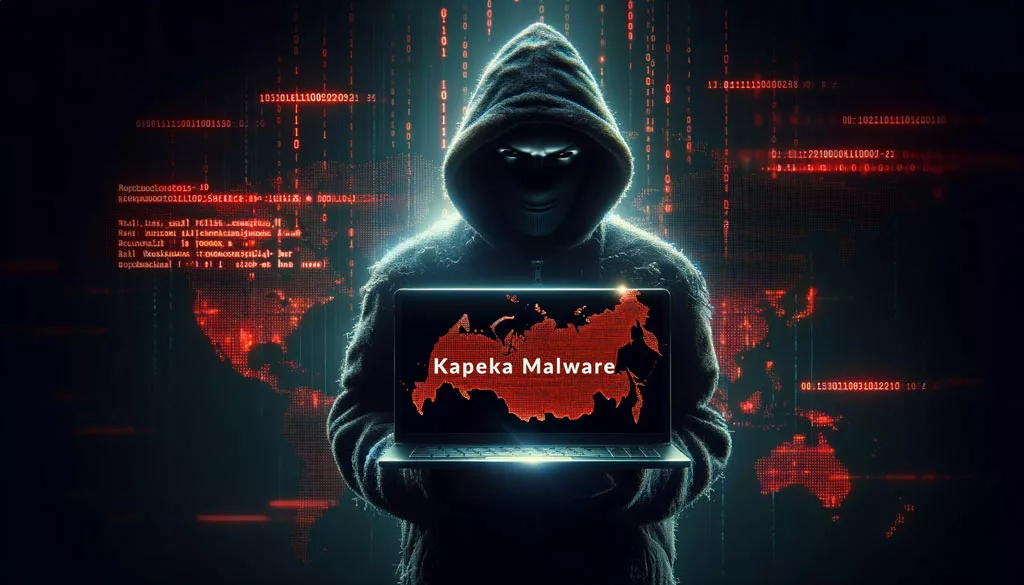2024, Digital Security
Kapeka Malware: Comprehensive Analysis of the Russian Cyber Espionage Tool
Kapeka Malware: Exploring Its Impact and Origin
Kapeka malware represents a formidable cyber threat emerging from Russia. This article delves into its sophisticated espionage tactics, offering insights into advanced cybersecurity solutions. Discover how to shield your digital landscape from such statesponsored threats and ensure robust data protection.
Unveiling Kapeka: The Emerging Russian Cyber Threat. Stay updated with our latest insights.
Kapeka Malware: The New Russian Intelligence Threat
In the complex world of cybersecurity, a new malicious actor has emerged, known as Kapeka. This sophisticated backdoor malware was first detected in Eastern Europe since mid2022 and has been actively used in attacks against victims in the region. WithSecure™ uncovered this novel backdoor, which they have been monitoring since its first appearance.
Context and Implications of Kapeka’s Cyber Espionage
Kapeka appeared against the backdrop of the ongoing conflict between Russia and Ukraine, seemingly used in targeted attacks across Central and Eastern Europe since the illegal invasion of Ukraine in 2022. It is likely that Kapeka was involved in intrusions that led to the deployment of the Prestige ransomware in late 2022. This malware represents an evolution in Sandworm’s arsenal, likely succeeding GreyEnergy, which itself had replaced BlackEnergy.
Operational Capabilities of Kapeka Backdoor
Kapeka is described as a flexible backdoor with all the necessary features to serve as an initial toolkit for its operators, as well as to provide longterm access to the victim’s infrastructure. The malware initially collects information and fingerprints the machine and user before sending the details to the threat actor. This enables the transmission of tasks to the machine or updating the backdoor’s configuration.
Global Cybersecurity Response to Kapeka Threat
WithSecure™, a cybersecurity company, discovered overlaps between Kapeka, GreyEnergy, and the Prestige ransomware attacks, all linked to the Sandworm group. Mohammad Kazem Hassan Nejad, Researcher at WithSecure Intelligence released an indepth technical report on the backdoor and its capabilities on April 17, 2024, as well as an analysis of the connection between Kapeka and the Sandworm group.
Advanced Cybersecurity Solutions Against Kapeka
To combat threats like Kapeka, advanced cybersecurity solutions such as DataShielder and PassCypher play a pivotal role. These solutions offer cuttingedge protection features that are essential in the current threat landscape.
Kapeka’s Contamination Methods
Understanding the contamination methods of Kapeka is crucial for developing effective defense strategies. Kapeka typically infiltrates systems through sophisticated phishing campaigns and exploiting known vulnerabilities. Once inside, it employs a multistage process to establish persistence and avoid detection :
- Initial Access : Kapeka often gains initial access through spearphishing emails, which lure individuals into executing malicious attachments or clicking on compromised links.
- Exploitation : It exploits vulnerabilities in software or systems to install the backdoor without user interaction.
- Establishing Presence : After gaining a foothold, Kapeka deploys its payload, which includes a backdoor that allows remote access to the infected system.
- Command and Control : The malware then establishes communication with a commandandcontrol server, which can issue commands, update the malware, or exfiltrate data.
- Lateral Movement : Kapeka can move laterally across networks to infect other systems, increasing the scope of the attack.
- Data Exfiltration : It can collect and transmit sensitive data back to the attackers, completing the espionage cycle.
By employing these methods, Kapeka can maintain a stealthy presence within a network, making it a formidable challenge for cybersecurity defenses. Organizations must employ advanced security measures, such as those provided by DataShielder and PassCypher, to detect and mitigate these threats effectively.
Statistics and Modes of Contamination
Kapeka’s contamination statistics reveal its targeted nature, with a focus on Eastern European entities. Its modes of contamination include :
- SpearPhishing : Targeted emails that trick users into executing malicious payloads.
- Exploiting Vulnerabilities : Taking advantage of unpatched software or system weaknesses.
- Dropper Files : Using seemingly benign files that deploy the malware upon execution.
Cybersecurity Tips to Thwart Kapeka Malware
In the battle against Kapeka, adhering to cybersecurity best practices is paramount. Here are some essential tips :
- Regular Updates : Keep all software and systems up to date with the latest security patches.
- Employee Training : Conduct regular training sessions to educate employees about phishing and social engineering tactics.
- Strong Password Policies : Implement strong password policies and encourage the use of password managers like PassCypher.
- MultiFactor Authentication (MFA) : Use MFA wherever possible to add an extra layer of security.
- Network Segmentation : Segment networks to contain and limit the spread of any infection.
- Backup and Recovery : Maintain regular backups and have a clear disaster recovery plan in place.
Detection and Protection Methods
To detect and protect against Kapeka, organizations should :
- Deploy Advanced Security Solutions : Utilize tools like DataShielder for encryption and PassCypher for password management.
- Security Information and Event Management (SIEM) : Use SIEM systems to monitor and analyze security alerts.
- Endpoint Detection and Response (EDR) : Implement EDR solutions to identify and respond to threats on endpoints.
- Regular Audits : Conduct regular security audits and vulnerability assessments.
DataShielder : NFC HSM and PGP Encryption
DataShielder provides contactless encryption using NFC HSM technology, ensuring secure data and communication management. Its offline key management system is particularly effective against network compromises, a common tactic used by malware like Kapeka.
PassCypher : Password Management and AntiPhishing
PassCypher revolutionizes password management with its NFC HSM, HSM PGP, and Engine components, offering contactless password management and realtime AES256 PGP encryption. Its antiphishing sandbox system is crucial for defending against typosquatting and BITB attacks, which are often employed by espionage malware.
PostQuantum Security and Anonymity
Both DataShielder and PassCypher provide postquantum AES256 CBC PGP encryption with segmented keys, some of which are physically offline. This level of encryption, combined with the absence of servers, databases, and the need for account creation, ensures complete anonymity and futureproofs security against emerging threats.
Implementing DataShielder and PassCypher
Integrating DataShielder and PassCypher into cybersecurity strategies offers robust protection against Kapeka and similar threats. Their advanced features ensure the confidentiality, integrity, and availability of sensitive data, making them indispensable tools in the fight against cyber espionage.
Deep Dive into Kapeka : A Comprehensive Malware Analysis
Contamination Tactics and Kapeka’s Spread
Kapeka has been used in targeted attacks in Eastern Europe since at least mid2022. It was first observed in an Estonian logistics company in late 2022. The exact mode of contamination is not fully known, but it is likely that Kapeka is distributed through phishing methods or other attack vectors that exploit security vulnerabilities.
Kapeka’s Data Harvesting Techniques
The Kapeka malware collects information and takes fingerprints of the machine and user before transmitting the details to the threat actor. This potentially includes sensitive data such as credentials, network configurations, and other critical information.
Strategies for Detecting and Protecting Against Kapeka Malware
To detect Kapeka, WithSecure™ researchers developed several artifacts, including a registrybased configuration extractor, a script to decrypt and emulate the malware’s network communication, and as might be expected, a list of indicators of compromise, YARA rules, and MITRE ATT&CK mapping.
Uncovering Kapeka : Insights from WithSecure™
The discovery of Kapeka is attributed to the researchers at WithSecure™, who published a detailed technical report on the malware and its capabilities on April 17, 2024. Their thorough technical analysis has shed light on the links between Kapeka and the Sandworm group.
Detailed Data Collection by Kapeka Malware
Kapeka is designed to perform thorough and meticulous data collection on infected machines. Here’s a detailed view of the types of data Kapeka is capable of collecting :
- System Information : Kapeka gathers information about the operating system, version, installed updates, and the presence of security software.
- Network Configuration : It identifies the machine’s network configuration, including IP addresses, domain names, and proxy settings.
- User Details : The malware can extract usernames, the groups they belong to, and associated privileges.
- Machine Fingerprints : Kapeka performs a fingerprint of the machine, which includes identifying hardware such as the CPU and memory, as well as connected peripherals.
- List of Running Processes : It monitors the processes running on the machine to detect suspicious activities or security software in action.
- Files and Directories : Kapeka can list files and directories, particularly those containing sensitive or corporate data.
- Active Network Connections : The malware analyzes active network connections to understand incoming and outgoing communication.
- Keystroke Data : Although not specifically mentioned in reports, malware of this type often has the capability to record keystrokes to capture passwords and other sensitive information.
Kapeka’s Infection Mechanisms
Kapeka uses sophisticated contamination methods to infiltrate target systems. It includes a dropper designed to install the backdoor on the victim’s machine, which then selfdeletes to avoid detection. The backdoor starts by collecting initial information and machine/user fingerprints before relaying details to the threat actor. The exact propagation method remains unclear, but historical patterns suggest phishing and exploitation of known vulnerabilities.
Geopolitical Implications of Kapeka’s Deployment
The development and deployment of Kapeka follow the ongoing conflict between Russia and Ukraine, with Kapeka likely used in targeted attacks since the illegal invasion of Ukrainian territory in 2022. The emergence of Kapeka is part of the increasing tensions between Russia and Western countries. This malware is an example of how cyber warfare is becoming an increasingly used tool in geopolitical conflicts. Cyberattacks like those carried out by Kapeka can have major repercussions on international relations, national security, and the global economy.
RealWorld Impact : Case Studies of Kapeka Attacks
Although specific details of attacks are often classified, it is known that Kapeka has been used against strategic targets, including critical infrastructure and key businesses. These case studies demonstrate Kapeka’s ability to disrupt operations and steal sensitive information, highlighting the need for robust cybersecurity.
Kapeka Versus Other Malware : A Comparative Analysis
Kapeka stands out from other malware due to its sophistication and ability to remain undetected for long periods. Unlike more widespread malware like WannaCry or NotPetya, Kapeka specifically targets organizations for reconnaissance and longterm information gathering operations.
Cybersecurity Tips in the Age of Kapeka
To protect against Kapeka and similar threats, it is essential to adopt a multilayered approach to cybersecurity, including regular system updates, employee training on phishing risks, and the installation of advanced security solutions.
International Reactions to the Rise of Kapeka Malware
In response to the threat posed by Kapeka, international organizations such as the European Union and NATO have strengthened their cybersecurity cooperation. Measures such as intelligence sharing and the development of collective defense strategies have become a priority.
Media and Education’s Role in Combating Kapeka
The media plays a crucial role in raising public awareness of cyber threats. Media education and good cybersecurity practices are essential to prevent the spread of malware and strengthen the resilience of individuals and organizations.
The Future of Cyber Warfare in the Shadow of Kapeka Malware
The future of cyber warfare is uncertain, but it is likely that malware like Kapeka will continue to play a significant role. Nations will need to invest in cyber defense and cyber intelligence capabilities to anticipate and counter future threats.
Sources of Discovery and Analysis of Kapeka Malware
The discovery and analysis of Kapeka can be attributed to cybersecurity firms like WithSecure™, which :
Publish Technical Reports : Provide detailed insights into the malware’s capabilities and modus operandi.
Share Indicators of Compromise (IoCs) : Distribute IoCs to help organizations detect Kapeka’s presence.
Collaborate Internationally : Work with governments and international agencies to share intelligence and strategies.
Concluding Insights on Kapeka’s Cyber Threat Landscape
The discovery of Kapeka underscores the importance of vigilance and international collaboration in the fight against cyber threats. As the threat landscape continues to evolve, detecting and analyzing malware such as Kapeka is crucial for anticipating and countering the operations of state threat groups. International unity is required to face these challenges and protect critical infrastructures from malicious actors.











